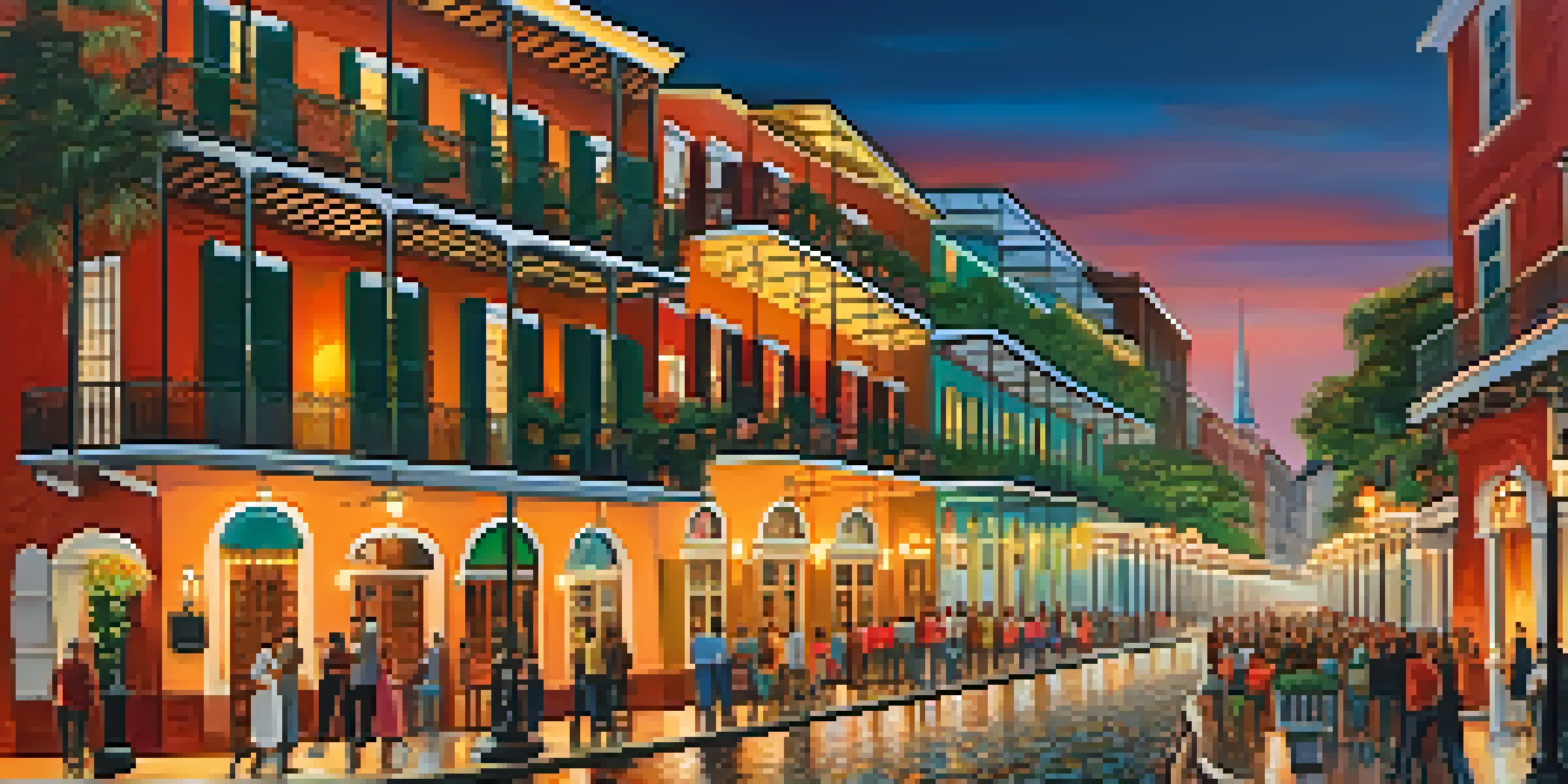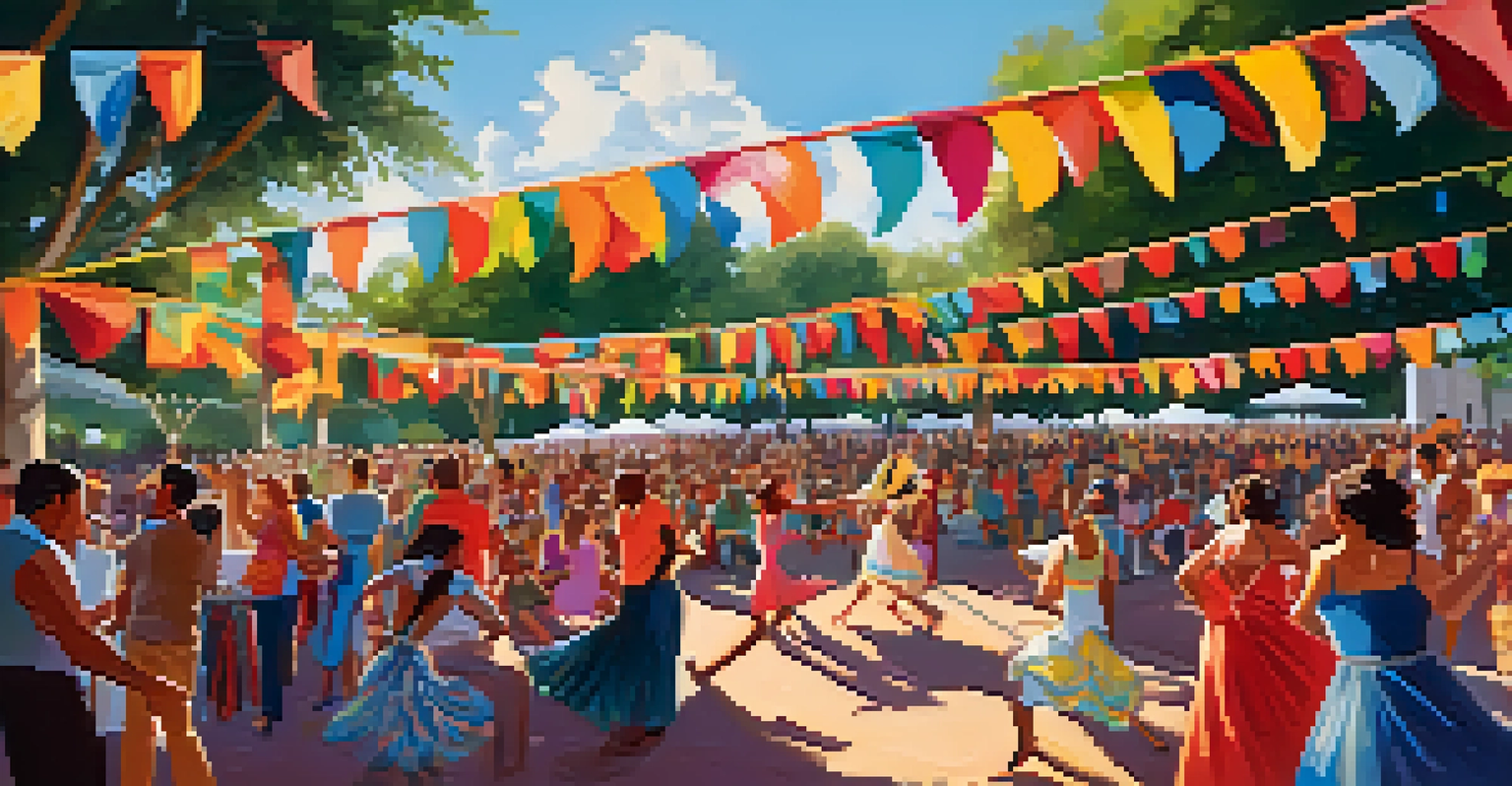Spanish Influence on New Orleans Architecture and Culture

The Historical Context of Spanish Rule in New Orleans
To understand the Spanish influence on New Orleans, it helps to start with history. After the French and Indian War, Spain gained control of New Orleans in 1763, and this rule lasted for several decades. This period was crucial, as it introduced new laws, customs, and architectural styles that would leave a lasting mark on the city.
New Orleans is a city that is a blending of cultures, and that blending can be seen in its architecture, cuisine, and music.
Spanish governance brought a distinct cultural flavor to the area, blending with existing French influences. As Spanish settlers arrived, they established a legal system known as the Code Noir, which regulated slavery and social order. This created a fascinating tapestry of cultural interaction that is still evident today.
When Spain ceded the territory back to France in 1800, many of the architectural and cultural influences had already taken root. Thus, even as New Orleans transitioned back to French control, the legacy of Spanish rule remained embedded in the city’s identity, serving as a foundation for its unique character.
Architectural Styles: Spanish Colonial Influence
One of the most visible impacts of Spanish influence is found in the architectural styles of New Orleans. The Spanish Colonial style is characterized by features such as red-tile roofs, wrought-iron balconies, and stucco exteriors. These elements create a warm and inviting atmosphere that many visitors associate with the city.

Notable examples include the Cabildo and the St. Louis Cathedral, where you can see the hallmark Spanish arches and intricate detailing. These structures not only serve as historical landmarks but also reflect the blending of cultures that defines New Orleans. Each building tells a story of the past, echoing the city’s vibrant history.
Spanish Rule Shaped New Orleans
The Spanish governance introduced unique laws, customs, and architectural styles that are integral to the city’s identity.
Even the layout of the French Quarter, with its narrow streets and intimate plazas, pays homage to Spanish urban planning. This design promotes social interaction, a hallmark of New Orleans culture, thus reinforcing the idea that architecture can shape community life.
The Role of Spanish Language in New Orleans Culture
Spanish has played a significant role in shaping the linguistic landscape of New Orleans. Many neighborhoods still reflect their Spanish roots through street names, folk sayings, and local dialects. This linguistic heritage adds a layer of cultural richness that enhances the city’s unique charm.
The legacy of Spanish rule in New Orleans is not just in the buildings we see but in the very spirit of the city.
Local phrases and terms, such as 'barrio' for neighborhood, are commonly used, illustrating how integrated the Spanish language is in everyday life. This connection to the past fosters a sense of belonging and continuity among residents, linking them to their ancestors.
Moreover, various cultural events often feature Spanish language components, from festivals to local music. This ongoing celebration of the Spanish language continues to reinforce its importance in New Orleans’ identity and culture.
Culinary Contributions: Spanish Flavors in New Orleans
Spanish influence is also deeply embedded in the culinary scene of New Orleans. The city’s unique cuisine showcases a fusion of flavors, where Spanish ingredients and techniques mingle with Creole and Cajun traditions. Dishes like paella and tapas have found a home alongside gumbo and jambalaya, creating an eclectic dining experience.
Popular restaurants often incorporate Spanish dishes into their menus, celebrating this culinary heritage. The use of spices such as saffron and the incorporation of seafood reflect Spanish cooking methods, adding depth to the local gastronomy. This blend of flavors mirrors the multicultural identity of New Orleans itself.
Culinary Fusion Reflects Heritage
Spanish flavors and ingredients blend seamlessly with Creole and Cajun traditions, creating a distinctive New Orleans cuisine.
Festivals like the annual New Orleans Wine & Food Experience highlight this culinary fusion, where chefs showcase their creativity by merging Spanish and local cuisines. By celebrating these culinary traditions, New Orleans reinforces its unique identity as a melting pot of cultures.
Cultural Festivals: Celebrating Spanish Heritage
New Orleans is famous for its vibrant festivals, many of which celebrate its Spanish heritage. Events like the Fiesta Española bring together music, dance, and cuisine to honor the city’s Spanish roots. This festival not only showcases traditional Spanish performances but also emphasizes the importance of cultural preservation.
The lively atmosphere at these events fosters a sense of community, bringing together people from diverse backgrounds to celebrate a shared heritage. Participants often dress in traditional attire, participate in traditional dances, and enjoy authentic Spanish food, creating a vibrant cultural tapestry.
These celebrations serve as a reminder that New Orleans is more than just a city; it's a celebration of cultural diversity. By highlighting Spanish influence, these festivals help to keep the rich history alive for future generations.
Spanish Impact on Music and Dance in New Orleans
The musical landscape of New Orleans is another area where Spanish influence shines. Traditional Spanish styles, such as Flamenco, have woven their way into local music, contributing to the city’s unique sound. This blend of rhythms and melodies creates a rich and diverse musical heritage that captivates both locals and visitors.
In many ways, the vibrant music scene of New Orleans reflects its multicultural roots. Styles like jazz, blues, and zydeco often incorporate elements of Spanish music, creating a sound that is uniquely New Orleans. This musical fusion showcases the city's ability to celebrate and integrate various cultural influences.
Cultural Festivals Celebrate Diversity
Vibrant festivals like Fiesta Española highlight the importance of Spanish heritage, fostering community and cultural preservation.
Dance, too, plays a significant role in this cultural exchange. Many local dance styles have been influenced by Spanish traditions, creating a lively atmosphere at festivals and social gatherings. Whether it's a lively salsa or a spirited flamenco, the rhythms of Spain continue to resonate in the heart of New Orleans.
The Lasting Legacy of Spanish Culture in New Orleans
The Spanish influence on New Orleans is a testament to the city’s rich history and cultural diversity. From architecture and language to cuisine and music, the marks of Spanish heritage are deeply ingrained in every aspect of life in this vibrant city. This legacy not only shapes the identity of New Orleans but also enriches the experiences of those who visit.
As time goes on, the importance of preserving this cultural heritage becomes increasingly vital. Community efforts to celebrate and maintain Spanish traditions help ensure that future generations will continue to appreciate the contributions of their ancestors. This commitment to cultural preservation is a key part of what makes New Orleans so special.

Ultimately, the Spanish influence is just one piece of the larger mosaic that defines New Orleans. By recognizing and celebrating this heritage, we can better appreciate the city’s unique charm and the rich tapestry of cultures that come together to create its vibrant identity.